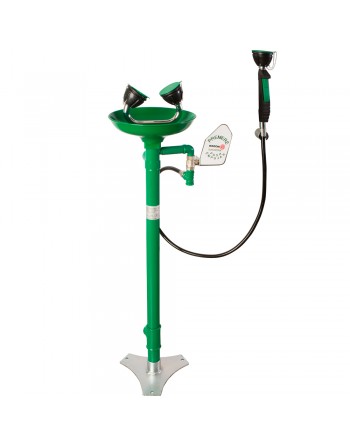Emergency eyewash showers are essential safety equipment in places where hazardous substances or chemicals are handled. They are designed to provide an immediate and effective response in case of chemical exposure or splashes, especially in environments where there is no fixed water system or in emergency situations.
What are emergency eyewash showers?
Emergency eyewash showers are self-contained devices that allow for the washing of both the eyes and the body in case of accidental exposure to hazardous substances. They are designed to be installed in strategic areas of the workplace, especially in areas where people may be at risk of contact with harmful chemicals.
Advantages of emergency eyewash showers
- Quick action: They provide an immediate solution in case of emergency, allowing for the rinsing of eyes and body without wasting time.
- Ease of use: Their activation is quick and simple, ideal for situations where every second counts.
- Versatility: They can be installed in various types of environments, from factories to laboratories and high-risk chemical areas.
- Regulatory compliance: They meet workplace safety standards and regulations, ensuring effective operation.
Norms and regulations
Emergency eyewash showers must comply with several safety standards to ensure their effectiveness in critical situations:
- UNE-EN 15154: European standard that sets the requirements for self-contained eye and body wash systems.
- ANSI Z358.1: American standard that regulates the design and operation of emergency showers, ensuring their availability and performance.
- Royal Decree 656/2017 APQ: Establishes the obligation to install safety equipment, such as eyewash showers, near areas with chemical hazards.
Key features of emergency eyewash showers
To ensure an appropriate response in emergencies, emergency eyewash showers must have the following features:
- High capacity: The systems must be able to provide a continuous flow of water for at least 15 minutes, following the recommendations of the regulations.
- Easy accessibility: The shower and eyewash system must be easily accessible at all times, with clear signage.
- Sterile water or additives: The water must be kept free of contaminants to prevent infections or complications.
- Durability: They should be designed to withstand adverse conditions, ensuring their operation even in extreme situations.
Maintenance and training
Maintenance and proper staff training are essential to ensure that emergency eyewash showers are always available:
- Periodic inspections: Check the system's operation, water quality, and activation mechanisms.
- Water replacement: Periodically replace the water to maintain rinse quality.
- Staff training: Ensure that workers are familiar with how to use the eyewash shower and know how to access it quickly in an emergency.
Emergency eyewash showers are a vital measure to protect eye health and worker safety in industrial and chemical environments. Select equipment that meets regulations and is suited to the conditions of your workspace.















